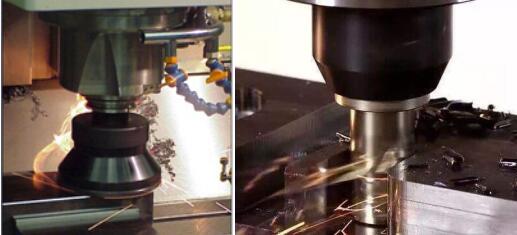In order to improve the wear resistance of mechanical parts and the service life of machinery, many mechanical parts made of structural steel need quenching treatment. Make the parts obtain high hardness, and then use grinding or EDM to get the final shape and precision. However, the processing efficiency of these processing methods is usually lower than that of cutting processing. In order to improve processing efficiency, nowadays, with the improvement of the performance of machine tools and cutting tools, the use of turning instead of grinding and milling instead of grinding has been gradually applied in the machinery industry. This article focuses on the parameter range of milling and the selection of cutting tools.
Quenching material milling parameter range:
(1) The cutting speed range of quenching material: from the current experience, the cutting speed range of cemented carbide tools is controlled at 30-75 m/min; the cutting speed range of ceramic tools is controlled at 60-120 m/min; CBN tools The cutting speed range is controlled at 100-200 m/min. When intermittent milling and workpiece material hardness is too high, the cutting speed should be reduced, generally about 1/2 of the minimum cutting speed above. For the best cutting speed during continuous milling, it is advisable for the cut chips to be dark red.
(2) Cutting depth range of quenching material: Generally, it is selected according to the machining allowance and the rigidity of the process system. In general, ap=0.1~3 mm. Currently, the tool materials for intermittent cutting quenching materials include BN-S20 and BN-H21 Two kinds of materials, BN-S20 grade is used for rough machining process with large margin, the cutting depth can reach 7-10mm, it can be directly milled without re-annealing treatment, BN-H21 grade is mainly used for fine machining of ≤0.5mm Processing procedure, high precision, long life;
(3) Feed rate: generally 0.05-0.4 mm/r. When milling quenched material intermittently, in order to reduce the unit cutting force, the feed rate should be reduced to prevent chipping and cutting; for the selection of processing feed rate, Halnn recommends selecting the tool according to the shape and size of the workpiece The angle can improve the processing efficiency and at the same time, it can effectively improve the service life of the tool.

Selection of Quenched Material Milling Cutters
The high hardness of the quenching material is generally above HRC50, so the requirements for milling tool materials are extremely strict. At present, the common materials are normal carbide and CBN tools.
1. Carbide cutting tools
(1) Select fine-grained and ultra-fine-grained (WC)-based carbide tools. Using cobalt as the bonding base, increasing the cobalt content can improve the toughness. Refining the grain can improve the hardness and wear resistance. The grain size of ordinary cemented carbide is 2-3Λm, the fine grain is 1-2Λm, and the ultra-fine grain is below 0.5Λm.
(2) TIC-based, Ti(C,N)-based cemented carbide. Using Ni2Mo as the binder, the specific gravity is small, the hardness of TiC-based alloy is high, the friction coefficient with steel is small, and the wear resistance is good; the performance of Ti(C,N)-based hard alloy is similar to that of TiC-based hard alloy, and its strength and plastic deformation resistance Higher than TiC-based cemented carbide.
(3) Coated carbide. Use CVD or PVD method to coat TiC, Ti(C,N), TiN, Al2O3 thin layer coated cemented carbide on the hard alloy substrate with good toughness, which can increase the cutting speed of cemented carbide and reduce the cutting force , increase wear resistance and service life.
2. CBN cutting tools
The hardness of the CBN tool itself is between HRC95-100, and the quenched material can be easily milled without adding a coating, especially the milling effect above HRC50 is more advantageous. The requirements for impact toughness are relatively high, and the effect of using BN-S20, BN-H20, and BN-H21 grades is more ideal.
The above three materials are all developed for intermittent milling. Among them, the BN-S20 material can be used for heavy-duty milling with a large margin, and the cutting depth can withstand 1-10mm. For the fine milling process, high-precision and high-surface quality quenching is required. In terms of grade, it is more reasonable to choose BN-H20 and BN-H21 grades, which can obtain a surface roughness within Ra0.8, and at the same time interrupted cutting without chipping and longer life.
If the simple tool life does not meet expectations, CBN inserts can also be coated to increase tool life. Compared with uncoated CBN inserts, the service life can be doubled.
